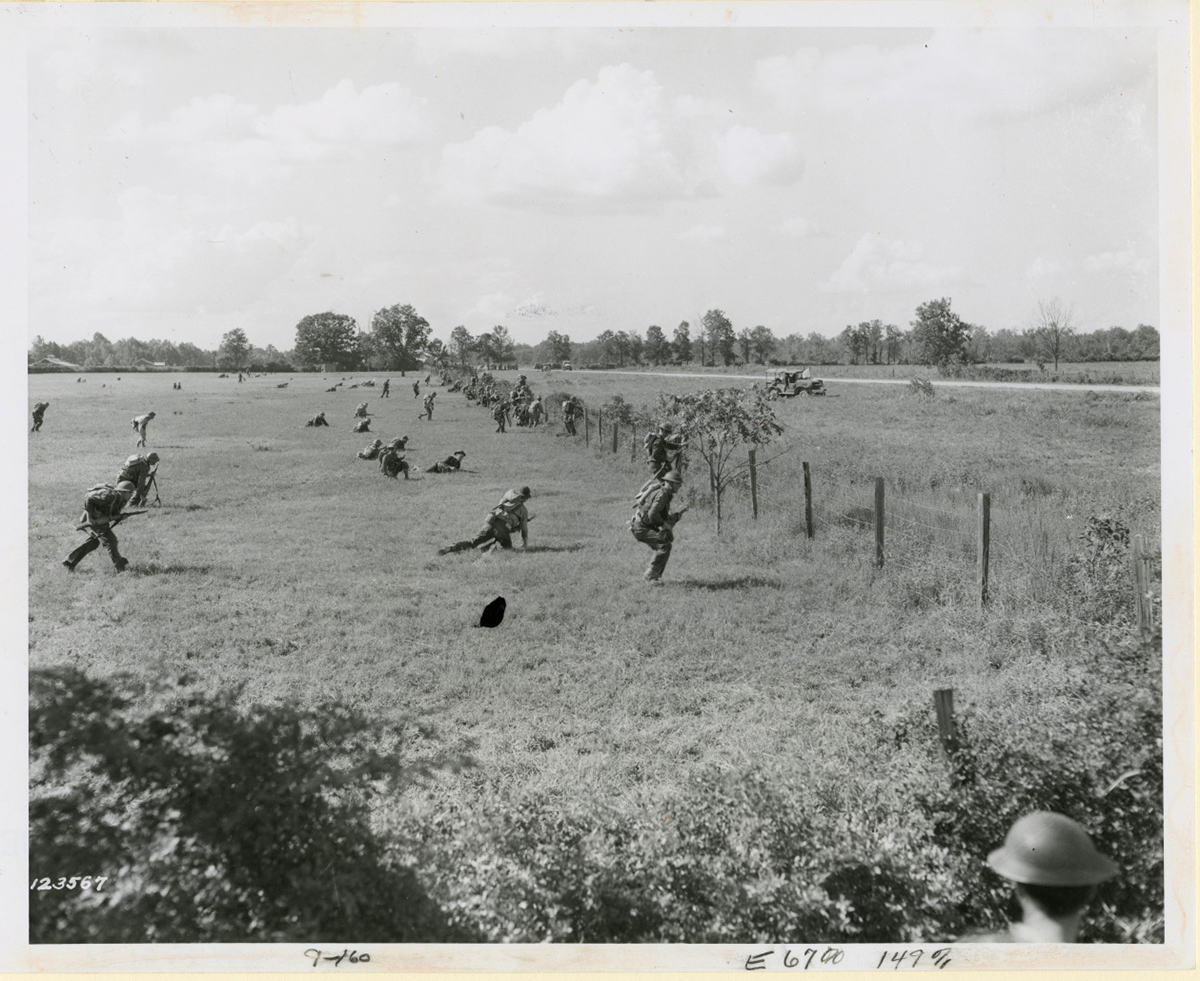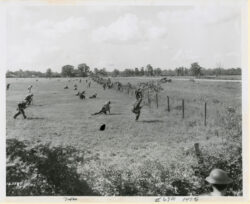Louisiana Maneuvers
During World War II, central Louisiana became the site of training maneuvers to prepare the United States Army to engage in Germany’s new blitzkrieg-style warfare.

The Historic New Orleans Collection
Troops of 124 Infantry, Louisiana Maneuvers, 1941.
During World War II the blitzkrieg, or “lightning war,” that Germany unleashed on Poland on September 1, 1939, sent shockwaves not only across Europe, but also across the Atlantic Ocean. The United States military realized that Germany had inaugurated a new style of warfare—one that used speed, surprise, and overwhelming force to ensure quick victory— with which it had little, if any, experience. That realization affected American military planning and helped lead to the Louisiana Maneuvers training exercises for the United States Army. The maneuvers contributed to American readiness to participate in global war and also bolstered Louisiana’s economy.
The 1940 Maneuvers
In 1940 army officials selected central Louisiana as the site of training maneuvers. Louisiana had once before served as the site for training American troops for battle. Camp Beauregard in Pineville had been a training center during World War I for National Guard troops and had accomplished that role well. Army officials therefore already knew of resources in the region. Additionally, Governor Sam Jones and Louisiana National Guard Adjutant General Raymond Fleming, promoted the idea. These factors led Lieutenant General Stanley Embick of the United States Army Fourth Corps Area to select central Louisiana as the site where the army would develop the techniques of modern, mechanized warfare.
The 1940 maneuvers were comprised of two series. The spring 1940 maneuvers pitted troops commanded by Major General Walter Short against opposing troops commanded by Major General Walter Krueger. These maneuvers revealed that the US Army needed training to transition to a motorized war, that command procedures leftover from World War I were not effective in a mobile war, and that American armored forces were inadequate for modern war.
The fall 1940 maneuvers with troops under commanding Major Generals Albert Blanding and Walter Krueger showed that National Guard troops needed additional training and that the army suffered from an appalling lack of modern equipment. Several famous images from the 1940 maneuvers showed the frightening aspect of American troops training with wooden sticks marked “rifle” and with trucks marked “tank” on their sides because adequate numbers of the real items were not available.
In addition to the valuable lessons learned by military planners, the 1940 maneuvers brought a measure of prosperity to central Louisiana because the troops involved received about $700,000 in pay, collectively, while there and spent much of it in area stores. In addition, the government spent about $87,000 per day in expenses, part of which found its way into the local economy.
The 1941 Maneuvers
Central Louisiana proved a good location for training exercises, especially because of the availability of 500,000 acres of federal lands in the Kisatchie National Forest, so the army returned for additional maneuvers in 1941. Some of the national forest at that time held cutover pine land that needed reforestation and thus could not be damaged by military use. The 1941 maneuvers were the most massive of the entire series and were the largest peacetime training maneuvers ever conducted by the United States Army.
The maneuvers began in May when the two fictional countries of “Kotmk” (Kansas, Oklahoma, Texas, Missouri, and Kentucky) and “Almat” (Arkansas, Louisiana, Mississippi, Alabama, and Tennessee) supposedly prepared for war over Kotmk’s navigation rights on the Mississippi River. Troops were mobilized for possible war as a navigation conference between the two “countries” supposedly dragged on at Memphis.
Central Louisiana was inundated with hundreds of thousands of troops before the military phase of the maneuvers began in August. Troops arriving early for the exercises were acclimated to battle noises by recordings of dive bombers, machine guns, cannons, and the wails of gas-warning sirens broadcast over loudspeakers placed throughout the area. As the starting date neared, central Louisiana hummed with activity, a marked uptick from the stagnation of the 1930s. During the latter part of July 1941, between three hundred and four hundred military vehicles passed through downtown Alexandria each day, creating massive traffic problems. Soldiers arrived by the thousands—about five thousand on July 30, ten thousand on July 31, and another five thousand on August 1, for example.
The training area stretched over most of central and western Louisiana. Residents throughout the region became used to the presence of troops in their neighborhoods, the sounds of battle, and the experience of living in areas “captured” by one army or the other. Motorcades, sometimes miles long, passed by their houses. Rail lines connecting some of the army training camps in the region were deliberately blown up using military tactics, both to test whether those tactics worked and how rapidly army engineers could make repairs to put the lines back into operation.
The 1941 maneuvers continued to demonstrate the weakness of conventional army forces under the conditions that prevailed on actual World War II battlefields. In 1941 General George S. Patton confirmed that tanks could operate effectively even in the marshy, inhospitable ground found in Louisiana and that conventional American defensive strategies were not effective against their attacks. In the rural Louisiana landscape, the army also learned about reconnaissance and troop supply problems and thus had several months to begin to address these problems before American entry into the war in December 1941.
The 1941 maneuvers also brought many of the top American military commanders during World War II to central Louisiana to obtain near-battlefield experience. At one time or another, Generals George Marshall, Dwight Eisenhower, George Patton, Joseph Stilwell, and Omar Bradley, among many others, either commanded troops or observed the exercises. The presence of so many top commanders and strategists led to a story that can still be heard today, though it was never substantiated: that preliminary plans for the D-Day invasion were initially conceived in the Mirror Room lounge in the Hotel Bentley in downtown Alexandria, which served as headquarters for most of the high-ranking military officers.
The 1941 maneuvers were important not only for the military information provided to army planners, but also for the Louisiana economy. The army payroll for the latter part of August was the largest processed in Shreveport up to that time, approximately $900,000. Much of that money found its way into the hands of central Louisiana merchants.
Businessmen in Alexandria kept extended hours during the Labor Day weekend and reaped the attendant benefits. Some storekeepers reported selling their entire stocks, especially of tobacco, candy, and refreshments. Theaters and restaurants experienced constant lines of people waiting for seats, and some smaller store owners reported selling as much merchandise in a day as they had sold in a year during the economic downturn of the Great Depression. One study of the economic impact of the 1941 maneuvers concluded that they added about $25 million to the state’s economy.
Economic benefit, however, came at a cost. The maneuvers contributed to problems in central Louisiana transportation for the rest of the war years. The average vehicular traffic in the maneuver zone rose from 40,762 vehicles per day in 1940 to 95,023 in 1941. The state requested assistance from the federal government to upgrade its roadways, including a request to the Public Works Administration to improve highway markings for nighttime driving in the maneuver area. Louisiana also requested more than $2 million in December 1941 to repair roads damaged during army exercises.
Because of the shortages of labor and material caused by the war effort, however, federal funding did not guarantee access to needed materials. Even though the Public Roads Administration began repairs in February 1942, many highways in the maneuver area remained in poor condition for years.
Later Maneuvers
The army returned to central Louisiana during 1942 and 1943 for additional maneuvers, which focused on specific problems encountered by the military, but maneuvers planned for 1944 were canceled because the troops who were to be trained were sent to bolster the D-Day invasion instead. That cancellation ended the series of Louisiana Maneuvers.
